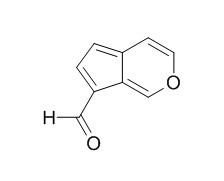Norviburtinal
Norviburtinal possesses novel angiogenesis effect. Norviburtinal and isopinnatal show in vitro cytotoxicity against cancer cell lines, norviburtinal has little selectivity for melanoma cell lines whilst isopinnatal also shows some cytotoxic activity.
Inquire / Order:
manager@chemfaces.com
Technical Inquiries:
service@chemfaces.com
Tel:
+86-27-84237783
Fax:
+86-27-84254680
Address:
1 Building, No. 83, CheCheng Rd., Wuhan Economic and Technological Development Zone, Wuhan, Hubei 430056, PRC
Providing storage is as stated on the product vial and the vial is kept tightly sealed, the product can be stored for up to
24 months(2-8C).
Wherever possible, you should prepare and use solutions on the same day. However, if you need to make up stock solutions in advance, we recommend that you store the solution as aliquots in tightly sealed vials at -20C. Generally, these will be useable for up to two weeks. Before use, and prior to opening the vial we recommend that you allow your product to equilibrate to room temperature for at least 1 hour.
Need more advice on solubility, usage and handling? Please email to: service@chemfaces.com
The packaging of the product may have turned upside down during transportation, resulting in the natural compounds adhering to the neck or cap of the vial. take the vial out of its packaging and gently shake to let the compounds fall to the bottom of the vial. for liquid products, centrifuge at 200-500 RPM to gather the liquid at the bottom of the vial. try to avoid loss or contamination during handling.
Biochem Pharmacol.2020, 178:114083
Antiviral Res.2013, 98(3):386-93
Pharmacol Rep.2022, 74(1):175-188.
Korean Journal of Pharmacognosy.2015, 46(4):352-364
Journal of Research in Pharmacy.2022, 26(6):p1752-1757.
J Biol Chem.2021, 297(6):101362.
Oncol Rep.2021, 46(2):166.
Journal of Ginseng Research2023, 12.004.
J.Soc.Cosmet.Sci.Korea2024, 50(3): 261-270
Nutrients.2018, 10(12):E1998
Related and Featured Products
Planta Med. 2000 Dec;66(8):758-61.
In vitro cytotoxicity of norviburtinal and isopinnatal from Kigelia pinnata against cancer cell lines.[Pubmed:
11199138]
METHODS AND RESULTS:
Crude dichloromethane extracts of Kigelia pinnata stem bark and fruit showed cytotoxic activity in vitro against cultured melanoma and other cancer cell lines using the Sulphorhodamine B assay, which was used for bioassay-guided fractionation.
Thin layer chromatography (TLC) examination of the most active fractions of both stem bark and fruits showed the presence of the same major components which were found to be Norviburtinal and beta-sitosterol. Norviburtinal was found to be the most active compound but had little selectivity for melanoma cell lines whilst isopinnatal also showed some cytotoxic activity. beta-Sitosterol was found to be comparatively inactive.
CONCLUSIONS:
HPLC analysis of the crude extract showed that the amount of Norviburtinal present in the plant material did not account for all of the activity of the total extracts.
J Ethnopharmacol. 2011 Oct 11;137(3):1323-7.
Bioassay-guided isolation of norviburtinal from the root of Rehmannia glutinosa, exhibited angiogenesis effect in zebrafish embryo model.[Pubmed:
21843616 ]
The root of Rehmannia glutinosa (RR) is commonly used as a wound-healing agent in various traditional Chinese herbal formulae; while angiogenesis is one of the crucial aspects in wound-healing.
The objective of the present study was to investigate the angiogenesis effects of RR aqueous crude extract and its active component(s) using zebrafish model.
METHODS AND RESULTS:
The in vivo angiogenesis effect was studied using transgenic TG(fli1:EGFP)(y1)/+(AB) zebrafish embryos by observing the capillary sprouts formation in sub-intestinal vessel (SIV) of zebrafish embryos after 72 h post-fertilization under fluorescence microscopy.
Our results indicated that RR aqueous crude extract (250 μg/ml) exhibited significant angiogenesis effect, with an increase in capillary sprouts formation in SIV. Following sequential solvent partition of the RR aqueous crude extract with dichloromethane, ethyl acetate and n-butanol successively, the dichloromethane fraction (DCM) was found to have the most sprouts formation in the SIV region. Subjected to column chromatography, DCM fraction was further fractionated into six sub-fractions and among these tested, the sub-fraction C2 exhibited the most potent angiogenesis effect. The major component, C2A, was isolated and identified as Norviburtinal using nuclear magnetic resonance (NMR) and mass spectrometry (MS). The compound Norviburtinal (at 50 μg/ml) was shown to possess significant angiogenesis effect in zebrafish model (p < 0.001).
CONCLUSIONS:
Norviburtinal was, for the first time, found in the extract of RR and possessed novel angiogenesis effect. Bioassay-guided fractionation suggested that Norviburtinal was not the only active component responsible for the angiogenesis effect of RR.



